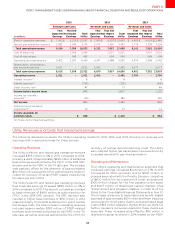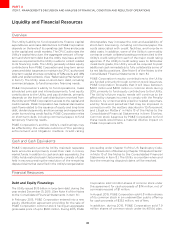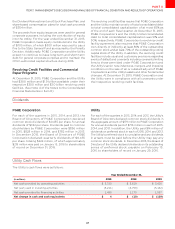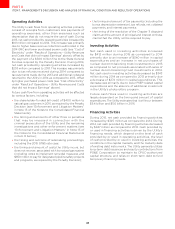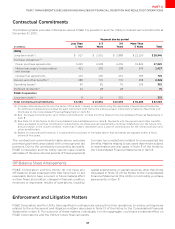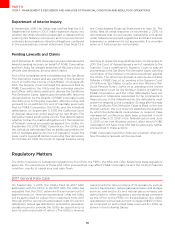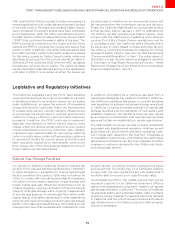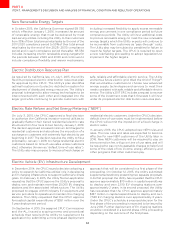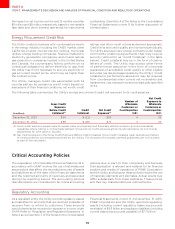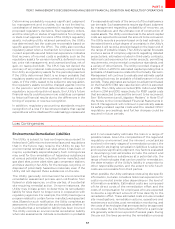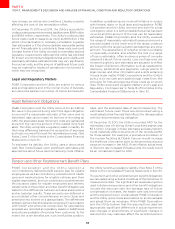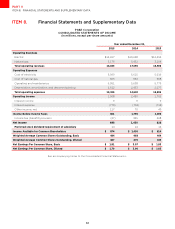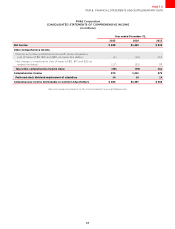PG&E 2015 Annual Report Download - page 61
Download and view the complete annual report
Please find page 61 of the 2015 PG&E annual report below. You can navigate through the pages in the report by either clicking on the pages listed below, or by using the keyword search tool below to find specific information within the annual report.
53
PART II
ITEM 7.MANAGEMENT’S DISCUSSION AND ANALYSIS OF FINANCIAL CONDITION AND RESULTS OF OPERATIONS
NRC granted the Utility’s request to delay processing its
renewal application until certain advanced seismic studies
of the fault zones in the region surrounding Diablo Canyon
were completed. The seismic studies have been completed
and in September 2014, the Utility submitted a report to
the NRC and the CPUC’s Independent Peer Review Panel
(“IPRP”) that confirmed the seismic safety of the plant. The
IPRP is providing comments on the report and the Utility
expects the IPRP to conclude their review and issue a final
report in 2016. In addition, the Utility has requested that
the California State Lands Commission extend the leases
for the land occupied by Diablo Canyon’s water intake and
discharge structures from the current expiration dates in
2018 and 2019 to 2024 and 2025 when the NRC operating
licenses are currently due to expire. The California State
Lands Commission has deferred acting on the application
until later in 2016. It is uncertain whether the leases will
be extended or whether an environmental review will
be required before the commission can issue a decision.
Finally, the California Water Board is not expected to issue
a final decision before January 1, 2017 to address how
the Utility’s nuclear operations at Diablo Canyon must
comply with the state’s policy regarding once-through
cooling. The Utility’s Diablo Canyon operations must be
in compliance with the California Water Board’s policy
by December 31, 2024. Based on these and other factors,
the Utility is continuing to assess its strategy for license
renewal of Diablo Canyon. (See Item 1A. Risk Factors and
“Environmental Regulation” in Item 1. For a discussion of
the Utility’s nuclear decommissioning obligations, see Note
2: Summary of Significant Accounting Policies – Asset
Retirement Obligations of the Notes to the Consolidated
Financial Statements in Item 8.)
Legislative and Regulatory Initiatives
The California Legislature and the CPUC have adopted
requirements and policies to accommodate the growth
in distributed electric generation resources (including
solar installations), increase the amount of renewable
energy delivered to customers, foster the development
of a state-wide electric vehicle charging infrastructure
to encourage the use of electric vehicles, and promote
customer energy efficiency and demand response
programs. In addition, the CPUC continues to implement
state law requirements to reform electric rates to more
closely reflect the utilities’ actual costs of service, reduce
cross-subsidization among customer rate classes,
implement new rules and rates for net energy metering
(which currently allow certain self-generating customers
to receive bill credits for surplus power at the full retail
rate), and allow customers to have greater control over
their energy use. CPUC proceedings related to some of
these matters are discussed below.
In addition, prompted by a methane gas leak from a
natural gas storage facility located in Southern California,
the California Legislature has begun to consider adopting
new legislation to address natural gas storage operations
in California, including increased oversight of natural gas
storage facilities and the adoption of new safety and
reliability measures. The California Governor also issued
an emergency proclamation that requires various state
agencies to take immediate action, as discussed below.
The Utility’s ability to recover its costs, including investments
associated with legislative and regulatory initiatives, as well
as its electricity procurement and other operating costs,
will, in large part, depend on the final form of legislative
or regulatory requirements, and whether the associated
ratemaking mechanisms can be timely adjusted to reflect
changes in customer demand for the Utility’s electricity
and natural gas service.
Natural Gas Storage Facilities
On January 6, 2016 the California Governor ordered the
Division of Oil, Gas and Geothermal Resources (“DOGGR”)
to issue emergency regulations to require gas storage
facility operators throughout California, including the
Utility, to comply with new safety and reliability measures,
including minimum daily inspection of gas storage well
heads (using gas leak detection technology such as
infrared imaging), ongoing verification of the mechanical
integrity of all gas storage wells, ongoing measurement
of annular gas pressure or annular gas flow within wells,
regular testing of all safety valves used in wells, establishing
minimum and maximum pressure limits for each gas storage
facility in the state, and establishing a comprehensive risk
management plan that evaluates and prepares for risks
at each facility, including corrosion potential of pipes
and equipment. The Utility may incur significant costs to
comply with the new regulations but anticipates that it
would be able to recover such costs through rates.
The DOGGR, the CPUC, the CARB, and the CEC will be
required to submit to the California Governor’s Oce a
report that assesses the long-term viability of natural
gas storage facilities in California. The report will address
operational safety and potential health risks, methane
emissions, supply reliability for gas and electricity demand
in California, and the role of storage facilities and natural
gas infrastructure in the State’s long-term GHG emission
reduction strategies.


